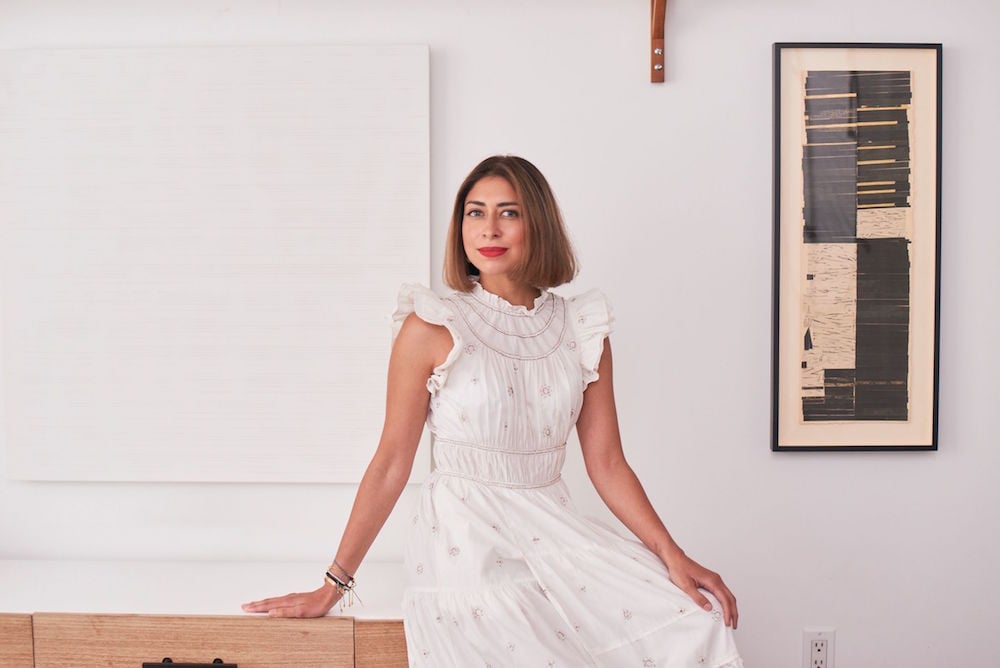
Sana Rezwan, a New York-based collector and entrepreneur who focuses on supporting South Asian women artists, is also the founder of the Art Lab Studio, which partners with luxury brands, nonprofit institutions, galleries, and artists to develop experiential programs.
Rezwan is active with several charitable organizations. A patron of the Metropolitan Museum of Art’s South Asian art department, she also sits on the advisory arts council of Harvard University’s South Asia Institute and is an honorary acquisitions committee member of the Jio World Centre.
We spoke with Rezwan about navigating the collecting world during lockdown, and why she thinks South Asian women artists have been sidelined.
Vasantha Yogananthan, Secret Door, (2016). Image courtesy Jhaveri Contemporary.
What was your first purchase (and how much did you pay for it)?
My first acquisition, for $27,000, was 24:00:01, a mixed-media piece by Shilpa Gupta that I saw at Frieze in New York in 2016, but purchased from Vadhera Contemporary. The work is concerned with the construct of time and how people use arbitrary measurements to document happenings, and Gupta inverts our very understanding of this.
I am also quite passionate about my role in the artist’s progression and my support of their visions. Collecting often takes on the character of an extended dialogue with the artist, sharing ideas on how their work is evolving and developing. From my first purchase on, I’ve had an exciting and profound view of Gupta’s body of work.
Ali Kazim, Untitled (Storm Series), (2018). Image courtesy Jhaveri Contemporary.
What was your most recent purchase?
My most recent purchases are a collage by Zarina from Luhring Augustine just prior to her passing, a map work by Bharti Kher, and a floor sculpture by Rana Begum.
I also have a commission in process with a young artist, Apnavi Makanji, who is based out of Switzerland, and will finish the piece later this year at my apartment in New York.
Yamini Nayar, Encounter, (2017). Image courtesy Jhaveri Contemporary
Which works or artists are you hoping to add to your collection this year?
I would love to include artists such as Simryn Gill and Mithu Sen to my collection. I have to admit, I do have quite a long wish list and it is hard to narrow down.
One focus of my collecting is on female artists from South Asia who have been traditionally marginalized or overlooked by the market, particularly those stereotyped or written off by galleries, academics, and other institutions.
If I see a lack of representation and a dearth of critical exploration of their work in the West, I will continue to collect and promote their work. I plan to continue this focus in the years to come.
Rana Begum, No.672MDrawing (2015). Image courtesy Jhaveri Contemporary
What is the most expensive work of art that you own?
se/hundred and ten (2018) by Prabhavathi Meppayil.
Where do you buy art most frequently?
Mostly art fairs and galleries, but now with everything being so restricted with travel and expositions postponed to 2021, I have no choice but to defer to a PDF list and a FaceTime walk-through, if not in person.
Daata is also a wonderful online platform offering video works. They have recently included a wide selection of pieces by South Asian artists, which has been a pleasure to browse through.
Is there a work you regret purchasing?
Not so far. Since I am a young collector, I am more cautious and do take my time in making purchase decisions. Most times I try to give myself a few days or sometimes months to think about what I buy next.
What work do you have hanging above your sofa?
A collection of 12 drawings by Aeysha Sultana from Experimenter Kolkata is behind my couch.
What is the most impractical work of art you own?
The works I gravitate towards are mostly minimal and anti-subjective or reductive in nature; so the pieces do not tend to be impractical or provocative, but rather poetic and meditative in gesture.
Bharti Kher, Japan (2018). Image courtesy Naturemorte Gallery
What work do you wish you had bought when you had the chance?
Reena Saini Kallat’s Saline Notations series from 2014. My biggest regret was waiting to decide, and I was too late!
If you could steal one work of art without getting caught, what would it be?
Museum of Chance (2013) by Dayanita Singh at MoMA, and Self Portrait (1932) by Amrita Sher-Gil at the National Gallery of Modern Art in New Delhi.